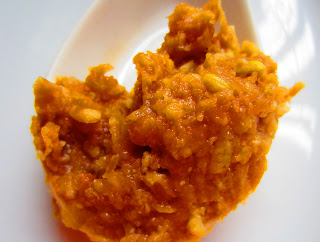 |
| Maitake mushroom |
We’ve had a few evenings on the chilly side lately and nothing feels better after a long day at school (or work) than sitting down with a huge bowl of miso soup and enjoying every spoonful of it. For the last 6 or 7 years I started every single day with a cup of miso but since I don’t do that anymore it is a special treat to have once in a while.
Miso soup is very well known in Asian communities and is consumed on a daily bases. While, in Japan, its history goes back centuries, it wasn’t until the 1960’s that this nurturing soybean paste was introduced in Europe, and later in the United States, as a main component of a new, cancer-prevention diet. With the macrobiotic movement spreading so rapidly, so did the availability of miso in health food stores. In macrobiotics, we refer to it as the “poor people’s health insurance”!!!What is miso?
Miso is a fermented paste, traditionally made of soybeans, rice, sea salt, and koji, or some kind of a starter. Nowadays you can easily find soy-free versions as well. The fermentation time will affect the color, the texture and the flavor. In general, the longer it was fermented, the darker the color and the stronger the flavor. If you’ve never tried it, you will probably want to start with a “light” miso, which will be a lighter color and will taste very sweet. The stronger versions will be much more on the salty side. They are the ones that were aged for 1 to 3 years and appear darker brown in color.
 |
| One-year, light, brown rice miso paste |
What’s in it for me?
Besides its flavor and versatility (it can also be used in salad dressings, spreads, marinades, as a flavoring, etc.), miso offers many health benefits, which is what gets me excited the most!
To mention just a few, it
• restores beneficial microflora in the intestines
• helps reduce the risk of many types of cancer
• contains alkaloids that chelate heavy metals
• is high in vitamin K, vitamin B2, and vitamin B6
• is rich in minerals, such as calcium, magnesium, copper, zinc, and iron
• helps digestion
• is a very good source of complete protein….good news for vegans! : )
…and there are many more!
Ready to test it?
Miso Soup
Ingredients:
(Serves 1-2)
2 1/2 cups water
1 tsp or 1 in piece wakame
2-3 shiitake or maitake mushrooms*
red chili pepper flakes (optional)
2 tbsp miso paste
green onions to garnish
*Shitakes are sold fresh or dried (in whole or sliced). If you’re using the dried version, you can rehydrate them by soaking them in water for a few minutes. If they’re sliced, you can use a handful in the soup right away, soaking is unnecessary. I prefer using fresh Maitake. They're sold as fresh, whole heads in health food stores.
 | |
| Dried shiitake mushrooms and miso |
Directions:
Put the water, the wakame, the mushrooms, and the chili flakes (if you are using any) into a small pot and warm it (if you eat raw) or get it hot but do not boil it. Let the vegetables simmer for a few minutes. While you’re waiting, take a little bit of the warm water out and mix it with the miso until you get a very smooth paste. You can do this in one of the serving bowls. Pour this paste back into the pot and let it simmer for a minute on very low heat and make sure you do not boil it! (You can even turn off the flame at this point and just leave the soup sit on the stove top for a minute.) It is very important to watch it because if you boil miso you will kill the enzymes and will miss out on the health benefits. Give it a stir and pour into serving bowls. Garnish with green onions. Enjoy!
More options:
You can start with just making a broth and skipping all the vegetables or try it with just the wakame.
If you eat tofu, you can add a couple of half inch slices cubed up.
Some people add soy sauce or shoyu.
Also, you can add any of your favorite vegetables cut into small pieces. I like to add daikon radish and, because of the color, thinly sliced carrots are a nice addition too.



No comments :
Post a Comment